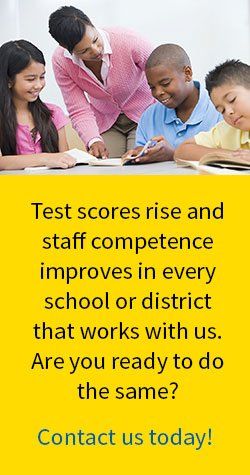21st Century Skills
Many of the 50 states have joined the Partnership for 21st Century Skills consortium. Member school districts are strongly urged to integrate these skills into their curriculum. If American students are to be successful citizens of the global marketplace, they must master such high-demand skills as collaboration, financial literacy, civic awareness, environmental consciousness, and the effective use of media and information. These skills must be thoughtfully integrated into the curriculum as part of every classroom.
Although several “lists” of 21st Century Skills are circulating, the “Partnership” list is one of the most comprehensive. The EdFOCUS team helps districts incorporate these skills into their curriculum using developmentally appropriate “work habits” and “products” at each grade level and within each content area. See the list below.
21st Century Skills Framework
The following checklist was adapted from 21st century skills lists published by the Educational Testing Services (ETS), the North Central Regional Education Laboratory (NCREL), and Learning for the 21st Century published by the Partnership for 21st Century Schools.
1.0 ACADEMIC CONTENT FOR THE 21st CENTURY
School curricula augmented by 21st century content (or digital-age literacy):
- Global Awareness and Multi-cultural Literacy
- Financial, Economic, and Business Literacy
- Civic Literacy
- Technological and Scientific Literacy
21st Century assessments that measure 21st Century skills and provide useful data to plan instruction:
- Valid and performance-based high-stakes assessments
- Classroom assessments that match content and cognitive demand of the standards
A renewed interest in student academic mastery and the perpetuation of learning:
- More rigorous expectations for mastery in the core content areas
- Legitimate and practical inter-connections among the subjects
- The integration of the arts into the core content areas
- Demonstration of mastery in life-context, beyond the classroom walls
Habits of learning that equip students to become lifelong learners:
- 1.1 Constructs meaning for oneself, and use real-world examples to demonstrate mastery
- 1.2 Reads critically (a diverse and balanced array of fiction, non-fiction, and poetry)
- 1.3 Writes persuasively
- 1.4 Thinks and reason logically and systematically
- 1.5 Uses creativity, and applies non-traditional strategies
- 1.6 Solves complex (multi-step; unfamiliar; challenging) problems with higher-order thinking
2.0 INFORMATION LITERACY
The ability to appropriately access and effectively use information (print and media):
- 2.1 Uses appropriate, valid, and current sources to collect or retrieve relevant information
- 2.1.1 primary sources (with appropriate citations)
- 2.1.2 secondary sources (with appropriate citations)
- 2.2 Evaluates the quality, relevance, degree of bias, and usefulness of information gathered
- 2.3 Organizes and manage information effectively to make viable decisions or proceed to further study
- 2.3 Interprets and present information correctly and accurately to inform, entertain, or persuade
- 2.4
Uses the ever-expanding array of technology gadgets and processes* to communicate, and observes the rules of on-line etiquette and the ethical use of social networks
*Such as word processing, e-mail, presentation software, the Internet, spreadsheets, decision support programs, design tools, e-learning, time management programs, and collaboration tools
3.0 SELF-DIRECTION and HIGH PRODUCTIVITY
The ability to exercise self-control adequate to successfully cope with uncertainty, and enough self-discipline to hold oneself accountable for a high level of productivity:
- 3.1 Shows adaptability, flexibility, and productivity in managing uncertainty and change
- 3.2 Shows curiosity, creativity, and risk-taking to solve a difficult problem or complete a puzzling task
- 3.3 Prioritizes, plans, and proceeds using time and resources appropriately
- 3.4 Uses real-world tools effectively to produce relevant, high-quality products
- 3.5 Analyzes new conditions as they arise, and identifies skills needed to deal with them; takes into account contingencies, and anticipates “plan B”—all independently
4.0 INTERPERSONAL SKILLS
The social and personal maturity to engage in successful two-way communication and to treat others with respect—particularly those of diverse backgrounds, experiences, and beliefs:
- 4.1 Works well as a team member, fulfills assigned responsibility to the group
- 4.2 Collaborates with others to arrive at reasonable consensus
- 4.3 Demonstrates social, civic, and personal maturity; takes responsibility for actions and deals with the consequences appropriately
- 4.4 Monitors and evaluates own behaviors, attitudes, and speech and recognizes mistakes and missteps; self-corrects and makes amends wherever possible
5.0 WORKPLACE LITERACY
The habits, attitudes, and behaviors that evolve into maximum productivity and a positive work ethic in the employment culture:
- 5.1 Observes designated work schedules, meets deadlines, and uses time wisely
- 5.2 Comes to work [class] prepared to work and remains focused for the duration
- 5.3 Puts forth the maximum effort, seeing work performance as a reflection of personal and social pedigree; takes pride in following directions
- 5.4 Demonstrates honesty and integrity in the workplace [classroom], and holds self accountable for actions and attitudes; uses constructive criticism to improve performance
- 5.5
Takes a leadership role when appropriate, and takes initiative to lead as needed without being asked
Close Your School’s Student Mastery Gap
Take the Self-Assessment
- All Ohio school districts are required to provide instruction so students can pass the Ohio State Tests (OST).
- When students fail to pass the OST tests, it reflects negatively on the school and the district as a whole.
Schedule a Consultation
- The EdFOCUS materials are written exclusively to the Ohio Standards and address the underlying level of thinking required for mastery.
- EdFOCUS materials are directly connected to the standards.
Improve Outcomes
- Classroom instruction is made more effective.
- District OST scores reflect mastery of content standards which generates public support and increases the state ranking.
Test scores rise and staff competence improves in every school or district that works with EdFOCUS.
Is your district ready to improve?
Contact Us
Is your school or district ready to improve student achievement?
Contact the EdFOCUS team today at (330) 842-0742.
©2023 EdFOCUS Initiative | Site Map | Privacy Policy | Accessibility

